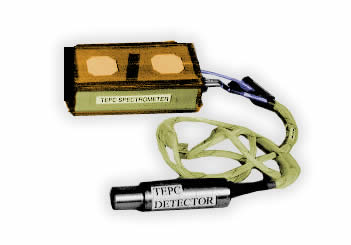

Solar Proton Events (SPEs) spew electrically charged protons and electrons and vast amounts of ionizing electromagnetic radiation from the sun. The radioactive particles and X-rays can do a great deal of damage to human cells. If they penetrate a human cell, they can cause structural damage that may lead to cell mutations, health problems, or the cell’s death.
 |
All radiation, even low-level background radiation, can damage exposed parts of the human body. Scientists use the term "rem" to describe an amount of radiation to which a person is exposed. A millirem is 1/1000th of a rem. Every person living in the United States is exposed to about 360 millirems of radiation per year. Medical procedures are responsible for approximately 60 of those millirems, while 300 millirems come from natural sources of radiation such as the sun and the earth’s soils and rocks. If you live near the Rocky Mountains, you would be exposed to an additional 40 millirems per year from uranium in the soil. If you live on the Atlantic Coast, you would be exposed to approximately 55 millirems per year from the air.
Many lifestyle factors increase a person's exposure to radiation. For example, a businessperson who flies from New York to California several times a month will have a higher exposure to radiation than one who drives a car. Every coast-to-coast roundtrip airplane flight exposes a passenger to 5 millirems of radioactivity. Every time a person has an X-ray, he or she is exposed to radiation. A chest X-ray exposes the body to 8 millirems of X-ray radiation, a head/neck X-ray to 20 millirems, and a lumbar spine X-ray to 130 millirems of radiation.
Through research, scientists have found how much radiation a person can absorb before danger symptoms appear. Different human cells respond to radiation in a variety of ways. Some cells may be able to repair themselves, some may begin to reproduce in an unusual way, and some may die.
Sometimes people are exposed to high doses of radiation in a very short period of time. Such exposure might occur during industrial accidents, medical emergencies, accidents in nuclear power plants, or war. Extreme instances of rapid exposure occur during the explosion of nuclear weapons or, if one is in space, during an SPE.
In cases where the whole body is exposed to 100 rems at a very rapid rate, human cells might be damaged and lose the ability to function. At exposures greater than 100 rems, a person may suffer immediate radiation sickness. The symptoms are flu-like in nature: diarrhea, nausea, and vomiting. At doses greater than 300 rems, the body's immune system could become permanently damaged. Fifty percent of the people exposed to doses greater than 400 rems at one time would die within 60 days if a doctor did not offer immediate treatment.
 Measuring
Radiation
Measuring
RadiationRadiation cannot be detected by the human senses. It cannot be seen, smelled, tasted, heard, or felt—until it is too late. Therefore, we use technology to help us detect radiation. The Tissue Equivalent Proportional Counter, or TEPC, is used on the space station. The TEPC is critical to astronaut safety.
Two TEPCs measure radiation on Space Station Alpha. A stationary TEPC is positioned in Destiny, the main research module. It measures how much radiation the astronauts could absorb if they stayed in that one area and did not shield themselves. A portable TEPC goes with the astronauts while they are moving about, even if they are shielded. The readings from the two TEPCs, measured in millirems, help the astronauts compare the amount of dangerous radiation penetrating the space station (TEPC #2) with the amount of radiation to which they have been exposed (TEPC #1).
Rad and Rem
As you have read, scientists use the terms "rads" and "rems" to describe radiation. A rem is one unit-measure of radiation to which a human body has been exposed. (Remember: rEm = radiation Exposed.) Rad (radiation absorbed dose) is the term used to describe the radiation that a body actually absorbs. (Remember: rAd = radiation Absorbed.) Radiation is absorbed while the body is exposed to ionizing radiation.
 |
A person's skin and protective clothing help to deflect some radiation. For this reason, the absorbed radiation does not always equal the radiation to which a body is exposed. For safety’s sake, however, 1 rem of radiation on board the space station is considered to be equal to 1 rad of radiation. The TEPCs can measure rems; it is impossible to measure the amount of radiation that is actually absorbed—until it is too late. For this reason, the astronauts use the measurement of rems of radiation to guide them while they are in space.
Time is an important factor in determining a dose of radiation. Radiation is absorbed over time. The total amount of radiation that a person is exposed to is called a "dose". The "dose rate" is the amount of radiation a person is exposed to during a given period of time. For example, if the dose rate is 50 millirems per hour, then a person has been exposed to a total dose of 50 millirems of radiation in one hour. At this same dose rate, the total dose in one-half hour would be 25 millirems.
|
Source
of Exposure
|
Exposure
|
|
X-rays from a T.V. set (sitting 1 inch away)
|
0.5 mrem/hour
|
|
Building materials (concrete)
|
3 mrems/year
|
|
Eyeglasses (containing thorium)
|
6 -11 mrems/year
|
|
Upper GI series (medical procedure)
|
245 mrems
|
|
Nuclear Power Plant (normal operation)
|
0.6 mrems/year
|
|
Three Mile Island (dose at plant duration of the
accident)
|
80 mrems
|
|
Natural gas in your home
|
9 mrems/year
|
|
Radionuclides in your body (i.e. potassium)
|
39 mrems/year
|
